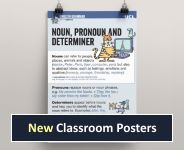Topics: Auxiliary verb or Conjunction
Auxiliary verb
Auxiliary verbs are 'helping verbs', which always accompany the main verb...
Conjunction
Conjunctions are words which link units together...
Englicious contains many resources for English language in schools, but the vast majority of them require you to register and log in first. For more information, see What is Englicious?

